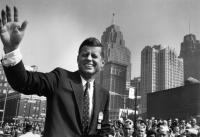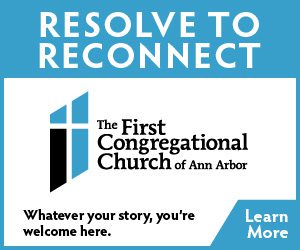I see him!” someone shouted and we all broke in applause. I jumped up and down, as ten-year-olds will do when they’ve been standing and waiting for half an hour.
A small line of us stood on Woodward Avenue, Detroit’s main artery, across from my dad’s college textbook store. My older brother Alex and a couple of Wayne State students stood next to me. One student held a camera.
It was Saturday, October 6, 1962, and President John Kennedy was in town for some sort of meeting—with the unions? Democratic leaders? I don’t remember. But word had gotten out that afterward, he would be driving down Woodward Avenue. No one knew for certain if this was true, but it was exciting waiting, and the weather was perfect.
A police car came first, then a long convertible with the top down. Up front were the driver, and someone I guess was a Secret Service guy; in the back seat, Michigan Governor John Swainson, and next to him—our president. My first reaction was shock: his hair looked redder than in the pictures! Not orange red, but what you’d call copper.
He looked toward our group, smiled like he’d been waiting for this moment, and waved. I felt disappointed that he didn’t look directly at me but I shouted out “Hi, Kennedy! Hi, Kennedy!” My brother shouted “Hi, John!” Someone else added “God Bless You, Mr. President!” The Wayne State student clicked his camera. The president waved again, the convertible continued down Woodward trailed by a security car, and it was over.
“You’ll be able to tell your grandchildren you saw the President of the United States,” the Wayne student said to me.
Barely a week later, the country was caught in the terror of the Cuban Missile crisis. We kids picked up the fear, too, and talked about our country being bombed by the Reds. I found some comfort in remembering the handsome man who smiled from his car. He would take care of us, wouldn’t he?
On November 22, 1963, when the president’s shooting was announced, I felt a terror that made the Cuban Missle crisis scare pale. Frightened, I raced home, eager to be with my mother, for comfort and to tell her the news that somehow I was convinced she didn’t know. But when she opened the door, her first words were, “He’s dead. I know.”
Like everyone, our family hunkered around the TV set the next few days to watch the now-iconic scenes: Jackie in the blood stained pink suit; Jack Ruby killing Lee Harvey Oswald; John John, age three, saluting his father’s casket.
When my elementary class gets together at reunions, we always talk about where we were when it happened, and how our principal dismissed school early and asked us to leave quietly. Although a lot has been written about how Kennedy’s killing impacted the generation of kids growing up, we don’t speculate on what it did to the deep places where we kept our fears and emotions. We stick to the facts. Where were you when you heard? Who told you?
I didn’t have grandchildren to tell about that day. And after Kennedy’s death, I seldom told anyone my story of seeing the president in person. Partly, as an adult, I realized it wasn’t that much of a story; I’d seen President Kennedy for a few seconds; his hair was redder than in the pictures. Also, as the years passed—my dad died, the store demolished—the ride down Woodward Avenue took on a dreamlike aura; it was pastel pink, not the brilliant pink of Mrs. Kennedy’s pillbox hat. I wished I’d gotten the phone number of the Wayne student to see the photos. Almost for proof.
In 1982, at some Michigan Democratic fundraising picnic, I met former Governor Swainson. I asked him if he remembered the ride down Woodward Avenue. Swenson, who has since died, took a bite of cake and told he remembered it very well. It wasn’t every day, he said, that you met a president.



thanks, Eve, for personalizing this story in a way that shows how a seemingly random moment in our lives can become so important and stay with us forever.
Gifts are the best mediators that speak the exact thoughts of minds out in an impressive manner.
New Year means happiness will arrive with a new spirit and hope. Make this each and every moment of the New Year very special and memorable with blessing of amazing Gift Hampers best available in online shopping store. Send excellent present along with your lovely wishes to Hongkong and express your love and deep affection.
Visit:
http://www.hongkongfloristshop.com/New_Year.asp
Confused about which Gift to send to your loved ones on this Valentine’s Day? We can share an easiest and most successful method of winning Hearts. Just pay a pleasurable visit to online shop and send lovely presents to your special ones in India.
Visit:
http://www.gifts-to-india.com
Make Valentine’s Day grander with this amazing Gift Hamper and share the moment with your loved ones. ThisValentine gift is best available at our online store. Send Gifts Hamper to India.
Visit:
http://www.gifts-to-india.com/valentines day.asp